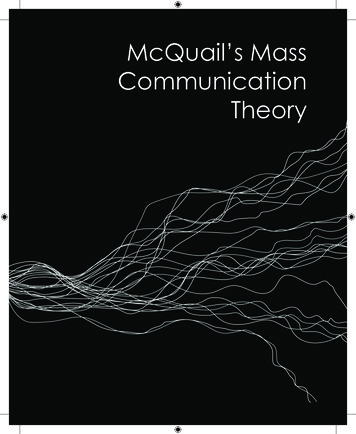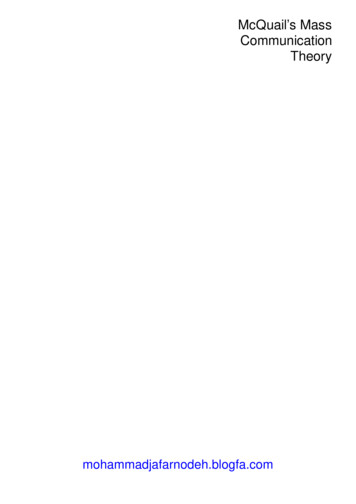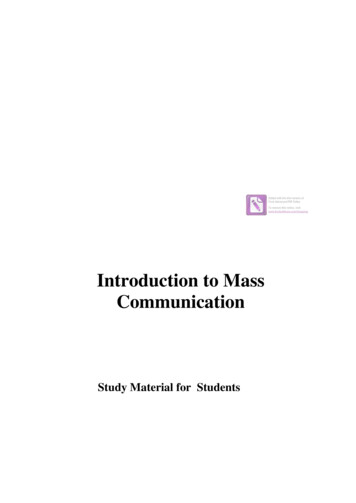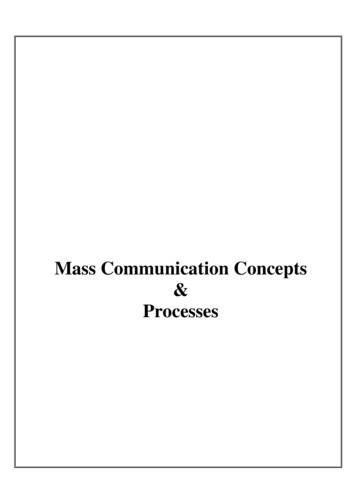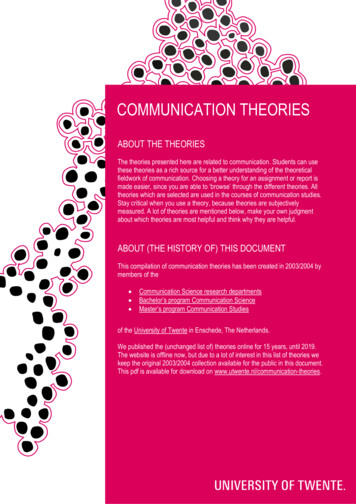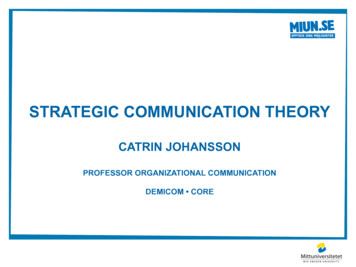
Transcription
STRATEGIC COMMUNICATION THEORYCATRIN JOHANSSONPROFESSOR ORGANIZATIONAL COMMUNICATIONDEMICOM CORE
DEFINING THE FIELDPublic relations refers to the management ofrelationships between organizations and their stakeholderpublics.Strategic communication is defined as purposefulcommunication of an organization to advance its mission.(Hallahan et al. 2007)
SUB-FIELDSOF RESEARCH AND PRACTICEv v v v v v v v v v Media relationsInternal communicationCommunity involvementCSR, Corporate Social ResponsibilityIssues managementCrisis communicationMarketing and brand communicationPublic affairsInvestor relationsLobbying
THEORIES IN THE FIELDv v v v v v v v v Systems theoryStrategic management of communicationRelationship managementAudiences, stakeholders, publicsRhetoricImage, reputation and identityPractitioners roles and professionalizationEthicsComplexity theory
STRATEGIC MANAGEMENTOF COMMUNICATIONThe old ”flying by the seat of the pants” approachto solving public relations problems is over. – Edward J. RobinsonProactive vs. Reactive communicationSuccessful communication does not just happen– it is a result of sound research, meticulous planning, carefulimplementation and evaluation.A British study shows that among the country’s most admiredcompanies, up to 70% of their communication activity is pre-planned.Cutlip, Center, Broom (2006) Effective public relationsTench & Yeomans (2006) Exploring public relations
COCA COLA AND CSRØ Goals and targets in five areas”Commitment 2020” - sustainabilityØ CSR initiative to launch an ecofriendly lightweight bottle for IceDew, its drinking water brand.Ø Reducing carbon footprint &recycling spaceØ Video illustrates how new designhelps environmentØ Media access to productmanager and brands ambassador
PLANNING AND STRATEGYv v v v v v v Focuses effortImproves effectivenessEncourages long-term viewAssists proactivity – setting the agendaReconciles conflicts – think through challenges in advanceMinimizes mishapsDemonstrates value for money
THE FOUR-STEPPUBLIC RELATIONS PROCESSAssessmentImplementationSituation AnalysisStrategy(Cutlip, Center, Broom, 2006)
1. SITUATION ANALYSIS”What’s happening now?”Defining strategic communication problems– What is the problem/purpose? (research the issue)– Who is involved?– Who should be talked to? (publics/people – relationship)– What concerns do these people have?– What factors influence the situation / publics? (internal/external)– SWOT analysis (strengths, weaknesses, opportunities, threats)– What methods for research are used?(key informants, interviews, focus groups, surveys,content analyses of newspapers, websites/Facebook/Twitter,workshops, advisory boards)
2. STRATEGY”What should we do and say, and why?”Planning and programming– What are the (SMART) objectives?– What are the key publics?– What should be said to whom? (messages, content)– How should the message be communicated?(communication channels)– What are the management expectations?– Time schedule– Budget– How is success to be judged? (evaluation of objectives)
3. IMPLEMENTATION”How and when do we say it?”Taking action and communicating– Coordinating action and communication– Mutual interests of the organization and its publics– Framing the message– Semantics and symbols– Barriers to communication– Dissemination / Dialogue
4. ASSESSMENT”How did we do?”Evaluating the program– Establish agreement on uses and purposes of evaluation– Secure organizational commitment to evaluation– Measurable results / evaluate the SMART objectives– Evaluate levels of preparation, implementation, and impact– Report evaluation findings to management– Add to professional knowledge
IMPACT CRITERIA Number of people who learn message contentNumber of people who change opinionsNumber of people who change attitudesNumber of people who behave in the desired fashionNumber of people who repeat or sustain desiredbehavior
WAY FORWARDPhoto: Yvonne Palm Lundström
CONTACT INFORMATIONCatrin JohanssonProfessor in organizational communicationMid Sweden UniversityE-mail: catrin.johansson@miun.sePhone: 46 60 14 88 04, 46 70-554 26 69
– Coordinating action and communication – Mutual interests of the organization and its publics – Framing the message – Semantics and symbols – Barriers to communication – Dissemination / Dialogue

